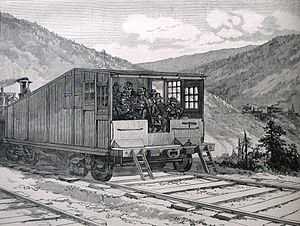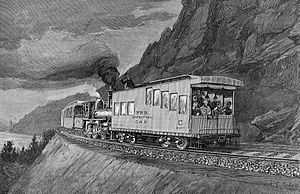Rail inspection

Rail inspection is the practice of examining rail tracks for flaws that could lead to catastrophic failures. According to the United States Federal Railroad Administration Office of Safety Analysis,[1] track defects are the second leading cause of accidents on railways in the United States. The leading cause of railway accidents is attributed to human error. The contribution of poor management decisions to rail accidents caused by infrequent or inadequate rail inspection is significant but not reported by the FRA, only the NTSB. Every year, North American railroads spend millions of dollars to inspect the rails for internal and external flaws. Nondestructive testing (NDT) methods are used as a preventative measures against track failures and possible derailment.
History

The first rail inspections were done visually. Many sources cite that the need for better rail inspections came after a derailment at Manchester, New York, in 1911. That particular accident resulted in the death of 29 people and injuries to 60 others. The investigation of the accident revealed that the cause was a transverse fissure (a critical crack which lies perpendicular to the length of the rail) in the rail. Further investigation in the late 1920s showed that this type of defect was quite common. With increased rail traffic at higher speeds and with heavier axle loads today, critical crack sizes are shrinking and rail inspection is becoming more important. In 1927, Dr. Elmer Sperry built a massive rail inspection car under contract with the American Railway Association. Magnetic induction was the method used on the first rail inspection cars. This was done by passing large amounts of magnetic field through the rail and detecting flux leakage with search coils. Since then, many other inspection cars have traversed the rails in search of flaws.
Defects and location

There are many effects that influence rail defects and rail failure. These effects include bending and shear stresses, wheel/rail contact stresses, thermal stresses, residual stresses and dynamic effects.
Defects due to contact stresses or rolling contact fatigue (RCF):
- tongue lipping
- head checking (gauge corner cracking)
- squats - which start as small surface breaking cracks
Other forms of surface and internal defects:
- corrosion
- inclusions
- seams
- shelling
- transverse fisures
- wheel burn
One effect that can cause crack propagation is the presence of water and other liquids. When a fluid fills a small crack and a train passes over, the water becomes trapped in the void and can expand the crack tip. Also, the trapped fluid could freeze and expand or initiate the corrosion process.
Parts of a rail where defects can be found:
- head
- web
- foot
- switchblades
- welds
- bolt holes
A majority of the flaws found in rails are located in the head, however, flaws are also found in the web and foot. This means that the entire rail needs to be inspected.
NDT methods
A list of methods used to detect flaws in rails:
- Ultrasound - the most popular method
- Eddy current inspection - great for surface flaws & near surface flaws
- Magnetic Particle Inspection (MPI) - used for detailed manual inspection
- Radiography - used on specific locations (often predetermined) such as bolt holes and where thermite welding was used
- Magnetic induction or Magnetic flux leakage - earliest method used to locate unseen flaws in the railway industry
- EMAT Electromagnetic Acoustic Transducer
Utilizing NDT methods
The techniques mentioned above are utilized in a handful of different ways. The probes and transducers can be utilized on a “walking stick”, on a hand pushed trolley, or in a hand held setup. These devices are used when small sections of track are to be inspected or when a precise location is desired. Many times these detail oriented inspection devices follow up on indications made by a rail inspection cars or HiRail trucks. Handheld inspection devices are very useful for this when the track is used heavily, because they can be removed relatively easy. However, they are considered very slow and tedious, when there are thousands of miles of track that need inspection.
Rail inspection cars and HiRail trucks are the answer to today’s high mileage inspection needs. The first rail inspection cars were created by Dr. Sperry. Since then, many new models have rolled out. These rail inspection cars are basically their own train with inspection equipment on board. The probes and transducers are mounted on carriages located underneath the inspection car. Modern day inspection cars now use multiple NDT methods. Induction and ultrasound methods can be used in rail inspection cars and operate at testing speeds of more than 30 mph (48 km/h). The next generation will go even faster.
There are many manufacturers of road/rail inspection trucks, otherwise known as HiRail trucks. These HiRail inspection cars are almost all ultrasonic testing exclusively, but there are some with the capability to perform multiple tests. These trucks are loaded with high speed computers using advanced programs which recognize patterns and contain classification information. The trucks are also equipped with storage space, tool cabinets, and workbenches. A GPS unit is used with the computer to mark new defects and locate previously marked defects. The Federal Railroad Administration (FRA) requires that any indications of defects need to be hand verified immediately. The GPS system allows a follow up car to find precisely where the flaw was detected by the lead vehicle. One advantage to the HiRail trucks is that they can work around regular rail traffic without shutting down or slowing down entire stretches of track. However, because railroad management frequently orders HiRail trucks to be used to inspect tracks at speeds over 50 mph (80 km/h), tracks reported as having been inspected are, in fact, not inspected. A NTSB report on the Amtrak derailment in Oregon in 2006 documented this fact.
The future of rail inspection
With increased rail traffic carrying heavier loads at higher speeds, a quicker more efficient way of inspecting railways is needed. Lasers inspect railway geometry, but one day they might be utilized as a form of non-contact evaluation of the rail. This most likely will be done with laser-optical transmitting transducers in ultrasonic testing. Eliminating contact with the rail could one day allow high speed detection of flaws. (Testing of rail is currently able to be done at 80km per hour with a Speno US-6 Ultrasonics train) Another need for the future is a complete rail inspection system. A step in this direction is deeper investigation of the rail by using low frequency eddy currents. Other advancements could include neural network analysis of signals to improve defect detection and identification and longitudinal guided ultrasonics. Improved rail quality, composition, and joining techniques could lead to better wear characteristics and a longer lifespan of the rail. Some investigation into banitic steels looks promising. A safe and portable means of filmless radiography could assist with onsite defect evaluation. These are just a few advancements in the process of being developed for future use.
Example trains
- Doctor Yellow (Japan)
- New Measurement Train (United Kingdom)
See also
- Maintenance of way
- Nondestructive testing
- Rail tracks
- Work train
- Track checker
References
- Cannon, D. F., Edel, K.-O., Grassie, S. L. & Sawley, K. “Rail defects: an overview.” Fracture & Fatigue of Engineering Material & Structures. vol. 26. no.10. pp. 865–886. Oct. 2003.
- Eddy Current Inspection. GE Inspection Technologies Ltd. – Hocking. April 5, 2005. http://www.hocking.com/applications/rail/.
- Federal Railroad Administration, Office of Safety Analysis. “Train Accidents by Type and Major Cause from Form: FRA F 6180.54. Jan.-Dec, 2004.” April 6, 2005. http://safetydata.fra.dot.gov/officeofsafety/.
- G-Scan. “Practical Application” Guided Ultrasonics (Rail) Ltd. April 6, 2005. http://www.guided-ultrasonics.com/rail/index.html.
- Judge, Tom, engr. ed. “Looking for flaws in all the right places.” Railway Age. vol. 203. no.12. pp. 29–31. Dec. 2002.
- Keefe, Kevin P. “Track classifications - Classifying and inspecting railroad track.” Trains Magazine. Sept. 10, 2002.
- National Transportation Safety Board. April 6, 2005. www.ntsb.gov.
- Rail Inspection. NDT Resource Center. April 5, 2005.
External links
- "MIL-STD-1699B, Nondestructive Evaluation of Butt Welds in Crane and Railroad Rails" (PDF). United States Department of Defense. 17 July 1992.
- Winchester, Clarence, ed. (1936), ""Detecting rail defects"", Railway Wonders of the World, pp. 919–924 illustrated description of the Sperry detecting system